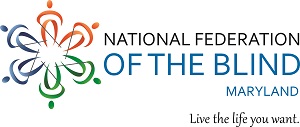To: Members of the Maryland General Assembly
From: Members of the National Federation of the Blind of Maryland
Contact: Sharon Maneki, President
National Federation of the Blind of Maryland
9013 Nelson Way
Columbia, MD 21045
Phone: 410-715-9596
Email: nfbmd@earthlink.net
Subject: Establishing the Maryland Remote Access to Information Program (RAIP) for Deaf-blind Individuals
Date: January 18, 2018
THE PROBLEM
Access to all types of information is the greatest obstacle to living a fruitful life faced by deaf-blind people today. They often remain isolated from family and friends, struggle to maintain independence and have difficulty in participating in all aspects of community life. Deaf-blind people need customized individualized services to overcome the barriers of dual sensory limitations. Maryland can reduce these barriers by putting new communications technology to work in serving the needs of deaf-blind citizens.
PROPOSED ACTION
The Maryland General Assembly should adopt legislation to create the Remote Access Information Program (RAIP), to be located in the Department of Disabilities to test the advantages of using technology to assist deaf-blind people in reaching full participation in all aspects of community life. This program shall be funded by the Telecommunications Access of Maryland (TAM) within the Department of Information Technology.
BACKGROUND
Deaf-blindness is a unique disability. Deaf-blind people use some of the techniques that blind people use and some techniques that deaf people use. However, they often need extra assistance to compensate for this dual sensory loss. Depending on the degrees of these limitations, deaf-blind individuals require customized, individualized services. Some communicate by using sign language while others use their voice. Some deaf-blind people acquire information by reading Braille while others read large print. In the most severe cases, individuals use manual deaf-blind fingerspelling. Regardless, they have the same desire for full participation in all aspects of community life as the rest of society. Many deaf-blind people do not achieve their goals for independence, education and employment because they cannot obtain the services they need.
The authors of the Americans with Disabilities Act (ADA) recognized the need to ensure that hearing and speech impaired individuals, including the deaf-blind, have the right to gain information and to communicate through telecommunications. Title IV of the ADA outlines the services that these individuals must receive. Deaf-blindness has always been one of the categories of disabled people to be served under Title IV of the ADA.
Telecommunications Access of Maryland (TAM) is a state agency within the Maryland Department of Information Technology that oversees all Maryland Relay services and programs, including the Maryland Accessible Telecommunications (MAT) program. MAT distributes telecommunications equipment needed by deaf-blind people to independently make or receive phone calls. Since the inception of Maryland Relay in 1991, deaf-blind individuals have been served in both the Relay and equipment distribution programs.
Communications and access to information have increased dramatically with the invention of the smartphone. Smartphones offer greater opportunities for deaf-blind people both to obtain information and enhance their ability to communicate with others. The use of a smartphone is not just limited to voice communication. For instance, people can use the smartphone to read or listen to text. Not only can smartphones be used to take pictures, but these pictures can then be transmitted to other smartphones or to computers. By judiciously linking a pair of camera-mounted eyeglasses and a smartphone, a deaf-blind person may take a picture of her environment, relay that picture to a human assistant located anywhere, and receive an accurate verbal or text description of the environment from that human assistant.
It is time for Maryland to provide the advantages of remote access information technology to its deaf-blind citizens.
ADVANTAGES OF THE RAIP
Services to deaf-blind children and adults in Maryland are very limited. The meager services that do exist are fragmented and not available statewide. The use of remote access information technology will allow the state of Maryland to serve more of its deaf-blind population. Personal assistants who are available to provide information to deaf-blind people in a local area will be able to serve a greater number of deaf-blind people in a larger area.
A second advantage is the greater flexibility of service delivery. For example, some deaf-blind people use a personal assistant to accomplish everyday essential tasks such as buying groceries. If an emergency occurs, a remote personal assistant would be able to meet this need more quickly because such service is on-demand. If a deaf-blind person wants to attend a job fair, but no one is available to physically accompany her, then the remote assistant could help by reading the signs for the various booths and describing other environmental information as she walks through the fair. This display of independence will make a great selling point to potential employers.
CONCLUSION
Deaf-blind individuals can be productive members of society if they receive the quantity and quality of services that they need to overcome the barriers created by their dual sensory limitations. Remote access technology should be considered as a method to decrease the large information gap experienced by deaf-blind people. Telecommunications Access of Maryland already has the responsibility to provide access to information for deaf-blind people. Therefore, they should take advantage of the advancements that remote access technology offers.
